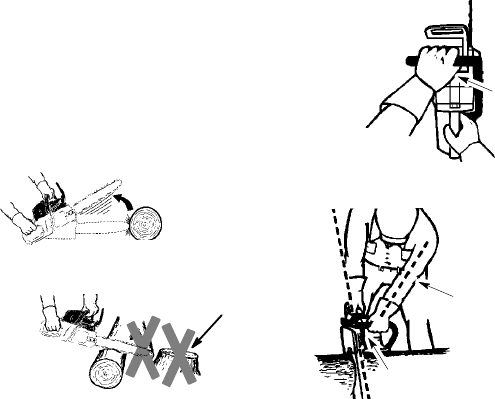
4
chain results in a reversal of the chain
force used t o cut w ood and causes the
sawtom ovei ntheoppositedirectionofthe
chain rotation. The saw is driven straight
back toward the operator.
S Pu ll-In can occur when the m oving chain
contacts a f oreign object in the wood in the
cut alongthe bottom ofthe guide barandthe
saw chain is suddenly stopped. This sudden
stopping pulls the saw forward and away
from theoperator and couldeasily cause the
operator to lose control of the saw .
Avoid Pinch--Kickback:
S Be extremely a ware of situations or ob-
structions thatcancausematerial topinch
the top of or otherwise stop the chain.
S Do not cut more than one log at a time.
S Do not twist the saw as the bar is with-
drawn from an undercut when bucking.
Avoid Pull--In:
S Always begincutting withtheengineatfull
speed andthesaw housingagainstwood.
S Use wedges made of plastic or wood.
Never use metal to hold the cut open.
Kickback Path
Clear The Working Area
Avoid Obstructions
REDUCE THE CHANCE OF
KICKBACK
S Recognize that kickback can happen.
With a basic understanding of kickback,
you can reduce t he element of surprise
which contributes to accidents.
S Neverletthem ovingchaincontactanyob-
ject at the tip of the guide bar.
S Keep the working area free from obstruc-
tionssuchasothert rees,branches,rocks,
fences, stumps, etc. Eliminate or avoid
any obstruction that your saw chain could
hit while you are cutting. When cutting a
branch, do not let the guide bar contact
branch or other objects around it.
S Keep your saw chain sharp and properly
tensioned. A loose or dull chain can in-
crease the chance of kickback occurring.
Follow man ufacturer’s chain sharpening
andmaintenanceinstructions. Check ten-
sion at regular int ervals with the engine
stopped, never with the engine running.
Make sure the bar nuts are securely tight-
ened after tensioning the chain.
S Beginand continuecutting atfullspeed. If
the chain is moving at a slower speed,
there i sgreaterchanceof kickbackoccur-
ring.
S Cut one log at a time.
S Use extreme caution when re-entering a
previous cut.
S Do not attempt cuts starting with the tip of
the bar (plunge cuts).
S Watch for shifting logs or other forces that
could close a cut and pinch or fall into
chain.
S Use the Reduced--Kickback Guide Bar
and Low--Kickback Chain specified for
your saw.
MAINTAIN CONTROL
Never reverse
hand positions
Stand to the
left of the saw
Thumb on
underside of
handlebar
Thumb on underside of
handlebar
Elbow locked
S Keepagood,firmgriponthesawwithboth
hands when the engine is running and
don’tletgo. Afirmgripwillhelpyoureduce
kickback and maintain control of the saw .
Keep the fingers of your left hand encir-
cling and your left thumb under the front
handlebar. Keep your right hand com-
pletely around the rear handle whether
yourarerighthandedorlefthanded. Keep
your left arm straight with the elbow
locked.
S Position your lefthandonthefronthandle-
bar so it is in a straight line with your right
hand on the rear handle when making
bucking cuts. Never reverse right andleft
hand positions for any type of cutting.
S Standwithyourweightevenlybalancedon
both feet.
S Stand slightly to the left side of the saw to
keep your body from being in a direct line
with the cutting chain.
S Do not overreach. Yo u could be drawn or
thrown off balance and lose control of the
saw.
S Donotcutaboveshoulderheight. Itisdiffi-
cult to m aintain control of saw above
shoulder height.


















